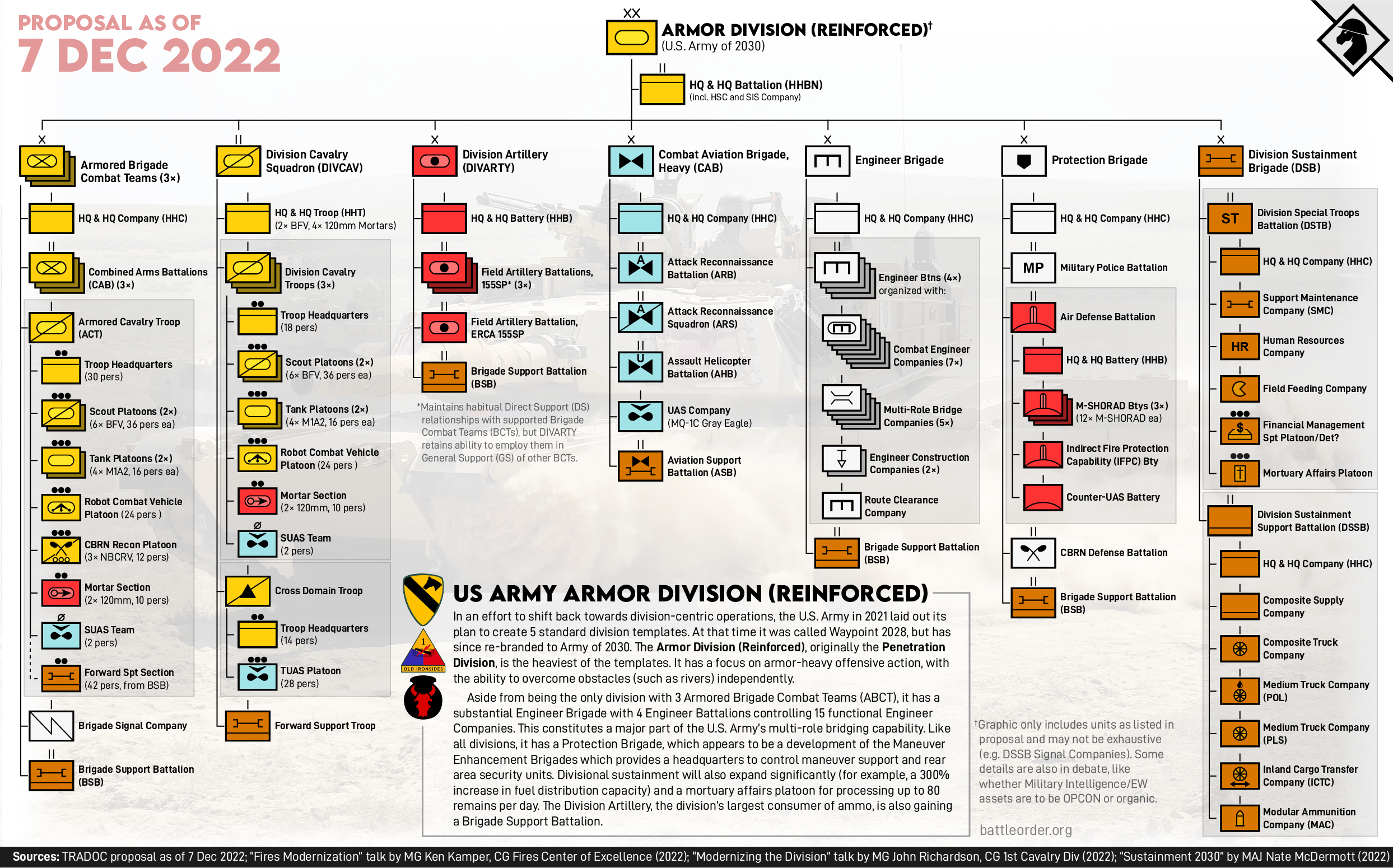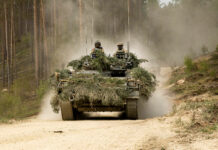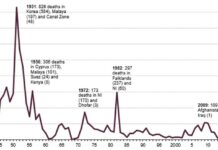The US Army is changing how it organises and deploys its manoeuvre force in response to ongoing and future threats. This reorganisation will have an impact on how this force communicates.
In 2016, the US Army created the Brigade Combat Team (BCT) as the basic, deployable manoeuvre unit. For all intents and purposes, the BCT is a combined arms formation. This means the brigade possesses organic infantry, armour, artillery, engineer and combat support elements. Three principle BCT configurations comprise the army manoeuvre force, namely Infantry (IBCT), Stryker (SBCT) and Armour (ABCT).
These formations are weighted according to their role. For example, an IBCT has three infantry battalions, a cavalry squadron providing the infantry battalions’ mechanised capability, an artillery battalion, plus engineer and combat support battalions. The SBCTs have a similar structure. The SBCT’s key difference is that it is built around General Dynamics Stryker family wheeled 8×8 Armoured Fighting Vehicles (AFVs). The Stryker BCT was conceived by the US Department of Defence (DOD) to be an air-deployable manoeuvre unit which could be in theatre within 96 hours. The ABCT has three combined arms battalions. These battalions contain rifle companies, as per the SBCTs and IBCTs, but each also has two armour companies. These companies deploy General Dynamics M1 Abrams family main battle tanks (MBTs) and BAE Systems M2 Bradly series tracked Infantry Fighting Vehicles (IFVs). As per the other brigade combat teams, the ABCTs has a cavalry squadron, plus artillery, support and engineering battalions.

Credit: US Army
According to the DOD, as of late 2022, the US Army has 58 BCTs, 31 of which are in the regular army and 27 of which are in the Army National Guard (ANG). The regular army has 14 IBCTs, the ANG has 20. Eleven ABCTs are in the regular army with five in the ANG. Two Stryker Brigade Combat Teams are in the ANG and seven are in the regular army.
The US Army began developing the BCT structure in 2002. As a paper by Adam Davis entitled ‘The Brigade Combat Team: A Revolution in Organisational Structure’ published by the University of Southern Maine in 2020 makes clear, the BCT concept was to develop comparatively small combined arms units of circa 2,500 soldiers. This was to offer improved agility compared to previous combined arms formations focused on the division. Divisions typically had strengths of around 10,000-15,000 troops.
The BCT reorganisation arguably reflected the United States’ contemporary strategic reality. The 11 September 2001 attacks perpetrated on US soil and the subsequent Global War on Terror, which began that same year with Afghanistan as its fulcrum, greatly influenced the BCT structure. US Army manoeuvre units would need to be largely self-sufficient. Self-sufficiency translated into organic combat units like artillery, engineer, and support units, and the wherewithal to rapid deploy across global distances. As Davis’ paper makes clear, the division was the ideal unit for fighting conventional war. Divisions were less ideal for waging the unconventional counter-insurgencies the US led in Afghanistan, and in Iraq from 2003.
Return of the Division
The only constant in military organisation is change. Once again history has played a card that has prompted another major reconfiguration of army manoeuvre formations. In a twist of irony, the US Army is returning to the division structure. To be clear, divisions did not disappear during the BCT era. Army division headquarters (HQs) would routinely deploy providing operational HQs with subordinate BCTs.
Two major, interlinked factors are driving the readoption of the division as the army’s principle, tactical unit of manoeuvre. These factors are the return of great power competition, as underscored by the rivalries existing between the US and her allies, with the People’s Republic of China (PRC) and Russia. As such, the army needs to be able to perform large-scale combat operations. The second is the adoption of the Multi-Domain Operations (MDO) philosophy by the US DOD. Both factors have major implications for how the army organises its manoeuvre force communications.

Credit: US Army
The Army 2030 vision, announced in January 2022, articulates the plans to move towards a division structure. Army 2030 emanated from the army’s Combined Arms Centre’s (CAC) 2018/19 Large Scale Ground Combat Operations multi-year study. Equally important was the work of the army’s Capability Integration Centre on Russia’s military modernisation. Readers interested in the background to Army 2030 should read the excellent white paper ‘How the Army 2030 Divisions Fight’. This paper was jointly published in February 2023 by the US Army’s Training and Doctrine Command (TRADOC) and the CAC.
The advent of MDO likewise influences the move towards the division. MDO envisages the connection of all personnel, platforms, weapons, bases and capabilities, henceforth known as assets, in a manoeuvre force, to perform synchronous operations at all levels and across all domains of war. MDO strives to improve the pace, quality, and efficiency of navigating the ‘OODA’ (Observe, Orient, Decide and Act) loop vis-à-vis one’s adversary. MDO is seen by the DOD as integral for defeating the Anti-Access/Area Denial (A2/AD) postures of potential adversaries such as the PRC.
The white paper cited above states that army divisions and corps will function as an integral part of a larger, joint force employing capabilities from sea, air, space and cyberspace domains. Divisions will sustain high-tempo combat operations over distance, protect critical nodes and assets, defeat land forces, and support and sustain all operations their assigned areas. As of mid-2023, it appears that the exact composition of the US Army’s divisions and timelines for their implantation are still being decided.
Centres of Gravity
BCTs currently use a bewildering array of radios and communications networks move voice and data traffic between their constituent elements and outwards to other formations and services. These systems were examined in detail in the author’s ‘Connecting the Force’ article in the March 2023 edition of ESD. The radios used by the BCTs, the waveforms they carry and their purposes are detailed in figures 1 and 2.

Credit: US Army
A recent US Army round table event entitled ‘Paradigm Shift: Division as Unit of Action’, provided some clarity on the influence that the adoption of the division could have on the army’s tactical communications posture. The event examined the communications networks that will underpin this new structure. One takeaway was that networks and systems must change to support the way the army wants to fight. A key change is the need to share information to and from the combat cloud. Manoeuvre force assets, and assets from other co-deployed services will continually share tactically relevant data with the cloud. Data could include video imagery, pictures, written reports or maps, for example. It will be necessary for the army to ensure that the division’s communications networks have the bandwidth to move this data. These links will have to be secure. The red force will realise the importance of the cloud and the networks moving data into and out of it. As a result, the red force will work hard to disrupt, degrade, and destroy these links using kinetic, electronic and cyberattack means. The centrality of the movement of information to aid efficient decision-making makes combat clouds and their communications links prime Clausewitzian centres of gravity in the opposing force’s eyes.
Technology
The good news is that much of the current technology the army needs to make this vision a reality already exists and is in service across the BCTs, said Matt Maier during the aforementioned round table. Maier is project manager for interoperability, integration and services at the US Army’s Command, Control, Communications-Tactical Programme Executive Office (PEO C3T). This includes commercial/civilian technology that the manoeuvre force is receiving in the form of the Integrated Tactical Network (ITN). The ITN uses civilian and commercial technology such as smartphones and tablets. These devices can use a variety of links, including civilian cell phone networks, to carry unclassified traffic around and beyond the manoeuvre force.
Speakers agreed that the need for communications to be survivable is paramount. This author estimates that Russia’s land forces deployed circa 80% of their Electronic Warfare (EW) capabilities into Ukraine. Division communications will need to operate in a contested EW environment, said Jeff Smith, L3Harris’ vice president of business development. This survivability will need to extend to reducing reliance on GNSS (Global Navigation Satellite System) services such as the US Global Positioning System (GPS). As well as navigation, GPS provides precise timing signals that electronic systems, including radios, depend on. Operating in a GNSS-denied environment will be a reality, said Smith. Here, the Ukraine theatre is instructive. Russian EW forces have enjoyed considerable success in jamming GNSS signals. Jamming has disrupted Ukrainian UAV operations and GNSS-reliant precision guided weapons like the US-supplied Joint Direct Attack Munition (JDAM). At the software level, low probability of detection/interception radio waveforms are vital alongside strong emissions control. Units should only be transmitting when they must. The rest of the time, they must remain electromagnetically opaque, said Smith.
The advent of digital fires tactics is indicative of the MDO direction of travel for US Army’s land manoeuvre force. Digital fires involve the rapid movement of precision fire coordinates digitally between computerised Command and Control (C2) and fire control systems (FCSs). This approach aims to reduce artillery sensor-to-shooter time and improve precision by reducing the danger that calls for fires will be misinterpreted. Returning to the combat cloud, this is where such a capability will become so important. For example, let us suppose an Unmanned Aerial Vehicle (UAV) detects a concentration of troops some distance from the tactical edge. The target’s coordinates and supporting imagery are uploaded to the cloud from the UAV. Commanders are advised by the UAV that a potential target has been spotted. The UAV’s target information is downloaded from the cloud and accompanies the subsequent call for fires sent to the division’s artillery.

Credit: US Army
Cloud computing could, in some cases, remove the need to have fixed command centres. A key lesson from Ukraine is that mobility means survival. Fixed headquarters are easy prey for Russian artillery, close air support and battlefield interdiction. Real-time, decentralised C2 is a must for the division, said Smith. Can headquarters elements remain mobile and dispersed but fully networked? One can think of this as the military equivalent of working from home – civilian office life regularly sees workers performing tasks remotely, but remaining networked with their colleagues and managers through the internet.
LOS and BLOS
Another challenge the division structure must contend with is land area. As a comparatively larger formation than the BCT, a division will by nature have a greater footprint. This brings challenges from a communications perspective. Manoeuvre formations such as the BCT rely on Very/Ultra High Frequency (V/UHF) radio spanning a waveband of 30 MHz up to 3 GHz for Line-of-Sight (LOS) communications.
Put simply, V/UHF cannot bend around the horizon. Thus two V/UHF radios must have a largely unobstructed line-of-sight to communicate with each other. A soldier carrying a V/UHF radio with a total height of 2 m (6.6 ft), including the radio’s antenna, on flat ground will have a LOS range of 5.8 km (3.6 miles). They will struggle to communicate with another V/UHF radio beyond this distance. For comparison, a vehicle with a V/UHF radio antenna with a total height of 5 m will have a LOS range of 7.9km (4.9 miles), and a 20 m high V/UHF antenna will have a LOS range of 18.4 km (11.4 miles). These ranges can be extended by using Mobile Ad Hoc Networking (MANET). This process lets radio traffic skip from one radio to another until it reaches its intended destination, the radio equivalent of a game of pass the parcel. Subordinate units in a BCT use Satellite Communications (SATCOM) to communicate at Beyond Line-of-Sight (BLOS) ranges. One example in this regard is the Mobile User Objective System (MUOS) SATCOM constellation.
Reliance on BLOS links will only increase in the future. Division units may sometimes be separated across hundreds of kilometres. Even MANET networks will not reach that far, meaning units will also depend on BLOS capabilities such as SATCOM. One capability which has shown its potential are comparatively low-cost commercial SATCOM constellations such as SpaceX’s Starlink system in widespread use in Ukraine. These constellations make use of comparatively inexpensive ‘CubeSats’ placed in Low Earth Orbit (LEO). Commercial SATCOM constellations could be used to move less-sensitive traffic, with classified communications moving across more secure networks such as MUOS. CubeSats typically have a mass not exceeding 10 kg (22lbs). Satellites in LEO are typically at altitudes under 1,000km (540 nautical miles), according to NASA’s definitions.

Credit: Lockheed Martin
Established technologies can help as ranges increase, said Smith. High Frequency (HF: 3 MHz to 30 MHz) radio transmissions skip across the horizon by bouncing off the ionosphere. The ionosphere is a layer of the atmosphere between 48 km (25.9 NM) and 965 km (521 NM) above Earth. HF helps to provide mobile voice and data while Very Small Aperture Terminals (VSATs) can be used for SATCOM. VSAT terminals have dish antennas between 750 mm to 1200 mm in diameter. As such they are relatively easy to move and set up, providing high bandwidth SATCOM at data rates of up to 16 mbps according to open sources. Smaller, directional SATCOM antennas are under development, according to the US Army. These antennas can equip vehicles and aircraft, automatically tracking where a satellite is in the sky. This ensures that transmissions and accurately sent and received while assets are mobile.
Interestingly, much of the effort of designing the division’s networking is focused on reducing complexity. Allied to this is an acceleration, and improvements in efficiency, concerning how the army introduces new communications and networking technologies. Agility is key to getting software and data-focused improvements into division networking, since much of the hardware is already there. The US Army is overhauling its tactical communications via the Handheld, Manpack, Small Form factor (HMS) programme. As noted above, civilian and commercial hardware forms part of the ITN. The software-centric nature of this hardware makes it relatively easy to update with new software applications as and when these become available.
People Potential
the manoeuvre force’s tactical communications is not just about the kit. Personnel form a vital part of the effort. The US Army round table event also noted that training forms a major part of the move towards the division and adapting communications and networking accordingly. Colonel Paul Howard, commandant of the US Army Signal School at Fort Gordon, Georgia, and the Army’s Chief of Signals, remarked during the round table that training processes and syllabi are already accommodating these changes.
The US Army faces the most formidable challenge to its combat power in a generation resulting from the changing strategic landscape and the threat posed by the PRC and Russia et al. Moving towards a division structure makes sense. Todays’ and tomorrows’ adversaries are numerically larger and more technologically sophisticated than those engaged by the US military in Afghanistan and Iraq. The challenge will be reorganising the manoeuvre force’s current networks to make them fit for purpose. Fortunately, the army already has several of the systems and architectures it needs for this effort. The embrace of new technologies such as cloud computing and CubeSats will help plug gaps and confer new capabilities. Investing in people will also pay dividends. Threats do not remain static. The US Army’s manoeuvre forces are showing they can move with as much, if not more agility, both technologically and tactically.
Figure 1 – Standard US Army Tactical Radios
| Manufacturer | Radio | Type | User | Frequencies | Selected Waveforms |
| Thales | Combat Net Radio | Single-channel handheld radio | Individual soldier radio | V/UHF: 30 MHz to 512 MHz |
SINCGARS, HAVEQUICK, IW, APCO-25 |
| L3Harris | Combat Net Radio | Single-channel handheld radio | Individual soldier radio | V/UHF: 30 MHz to 512MHz |
SINCGARS, HAVEQUICK, IW, APCO-25 |
| Collins Aerospace | AN/PRC-162 | Two-channel backpack radio | Vehicle mounted, dismounted, fixed site | V/UHF: 30 MHz to 1.850 GHz |
SRW, MUOS, SINCGARS, WREN TSM, IW, MUOS, SATURN, HAVEQUICK |
| L3Harris | AN/PRC-158 | Two-channel backpack radio | Vehicle mounted, dismounted, fixed site | V/UHF: 30 MHz to 1.850 GHz |
SRW, MUOS, SINCGARS, WREN TSM, IW, MUOS, SATURN, HAVEQUICK |
| L3Harris | AN/PRC-163(V)2/3 Leader Radio | Two-channel handheld radio for team leaders and above | Team, squad, platoon leaders. | V/UHF: 30 MHz to 2.6 GHz |
SINCGARS, APCO-25, SATURN, HAVEQUICK, MUOS, TSM, UHF SATCOM |
| Thales | AN/PRC-148C/D MBIRT/IMBITR Leader Radio | Two-channel handheld radio for team leaders and above | Special operations forces | V/UHF: 30 MHz to 512 MHz |
HAVEQUICK, SINCGARS, WREN-TSM |
| Thales | AN/PRC-170 Javelin Single Channel Data Radio | Single-channel handheld radio to support IVAS | IVAS | V/UHF: 225 MHz to 2.6 GHz |
TSM |
Figure 2 – Standard US Army Tactical Communications Waveforms
| Waveform | Frequency | Purpose |
| ANW2 (Army Networking Waveform-2) | UHF | Data communications between dismounted troops, vehicles and command centres. |
| APCO-25 | UHF | Used for first responder communications in the United States. |
| HAVEQUICK | V/UHF | Air-to-surface/surface-to-air tactical voice and data communications. |
| HF SSB with ALE (High Frequency Single Sideband with Automatic Link Establishment) | HF | Long-range over-the-horizon backhaul. |
| IW (Integrated Waveform) | UHF | Tactical SATCOM. |
| MUOS (Mobile User Objective System) | V/UHF | Tactical SATCOM. |
| SATURN (Second Generation Anti-Jam Tactical UHF Radio for NATO) | V/UHF | Surface-to-surface/air-to-surface/surface-to-air tactical voice and data communications. |
| SRW (Soldier Radio Waveform) | UHF | Surface-to-surface tactical voice and data traffic. |
| SINCGARS (Single Channel Ground and Airborne Radio System) | VHF | Surface-to-surface/air-to-surface/surface-to-air tactical voice and data communications. |
| TSM (Tactical, Scalable, Mobile Ad-Hoc Network)
WREN-TSM (Warrior Robust Enhanced Network Narrowband TSM) WREN NB (WREN Narrowband) |
V/UHF | Surface-to-Surface tactical voice and data traffic. |
| UHF SATCOM | UHF | Tactical SATCOM |
| WNW (Wideband Networking Waveform) | V/UHF | Tactical voice and data traffic. |
Thomas Withington











